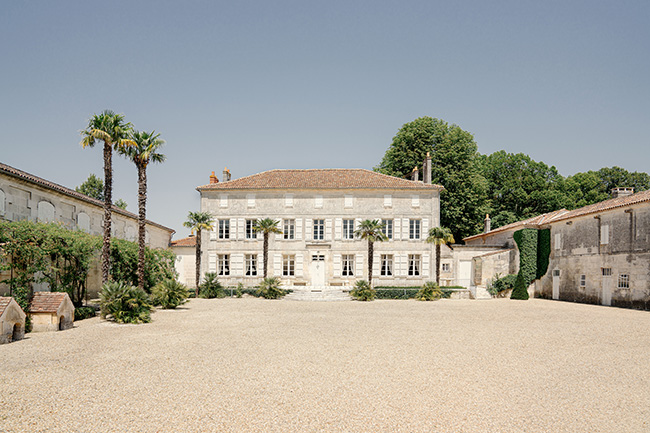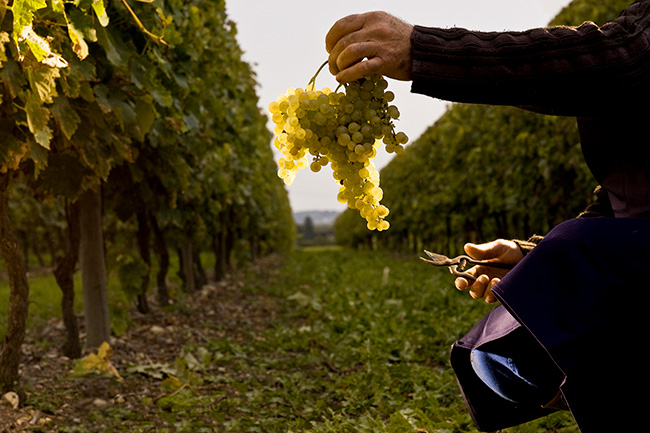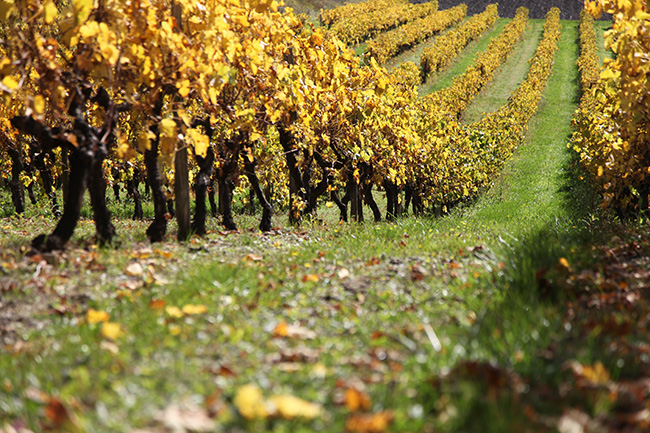Discovering the Incredible Craft of Cognac Making
Cognac is in the Charente department of Western France, between Angoulême and Saintes and is home to the production of true cognac, essentially a variety of brandy, named after the commune of Cognac itself. There are four main players in the world of cognac which include the houses Hennessy, Martell, Courvoisier and Rémy Martin. It is said that nine out of every ten bottles of cognac are from one of these acclaimed houses.

Visit the Domaine du Grollet in Charente © Domaine du Grollet
I visited the HQ of producer Rémy Martin who created the coveted and arguably the most luxurious, complex cognac on the market, Louis XIII, to learn more about the process from start to finish. My day started sat opposite a vineyard, the launchpad for where cognac begins life. Interestingly, I learnt that the soil is largely lime which encourages the vines to ‘suffer,’ because the roots must work hard to go through the density of the limestone up to 20 meters deep to obtain the nutrients beneath. It is a truism that the more a vine struggles, the better the wine will taste. Lime is a porous stone, so it absorbs all the rain throughout winter, holds on to it and then releases it during the summer. Being a white stone, it means the sun reflects off it around the vines which enables the growing climate to be even warmer.
As is often the case, there is a collaborative feel to farming, which is echoed within cognac producers, they can learn from one another how to deal best with climate changes and the company has proudly worked with some growers literally for generations. When it comes to variety, Ugni Blanc is the grape variety most used for cognac, however due to climate change, other adaptable varieties are currently being planted and researched but not yet used as they are not approved in Cognac-making law. Cognac producers use a total of six crus/regions, including Petite and Grande Champagne. Remy Martin however uses only Grande and Petite Champagne, which is their own appellation called ‘Fine Champagne’, whilst Louis XIII only uses Grande Champagne. The aromatic profile of the grapes exudes a balance and opulence of sweet notes, floral and spicy.

The vines need to ‘work hard’ to produce better quality grapes and thus, tastier wine © Domaine du Grollet
As I sipped Louis XIII, I was reminded that I was tasting the very time that has gone into it. Each decanter is the product of the forward-thinking Cellar Master who has carefully chosen the top eaux de vie, to create future generations of Louis XIII. Their current Cellar Master is Baptiste Loiseau, who undertakes copious tastings in the morning with a clean palette and hunger within. It is his job to keep aside the finest eaux de vie as a legacy to his successors for the next century.
As I walked around the dimly lit cellar, damp and smelling mushroomy, with ethereal cobwebs in the corner, I was told 2-3% of the liquid evaporates into the air, which they affectionately call the ‘angel share’ and amounts to a whopping 8 000 bottles worth per day. This prized potion destined to be cognac is stored safely in large rustic French oak barrels from the Limousin forest. The barrels, called tierçons, are patched up with parts of old barrels when needing repair. I was lucky enough to have a tour of the barrel-making facility, which had a marked medieval ambience, craftsman clad in aprons, clanging hammers, mini fires to toast or as they say in the trade ‘caramalise’ the wood which flavours the liquid which will be poured inside. The almost prehistoric moulding and mending with precision and passion ended up with a modern twist of a laser machine at the very end to bespoke brand, whether a logo or name.

Louis XIII Grande Champagne Vineyards in the autumn © Domaine du Grollet
Not only did I get a whirlwind tour depicting of the creation of cognac, I also received a masterclass in how to taste it. It is a common misconception that you should swirl the glass and warm it in your hand, the warmth will over oxygenate it and release too much alcohol on the nose, so you’ll smell alcohol first, tarnishing the taste. The most appropriate glass is a straight glass which balances the level of exchange between the oxygen and liquid in your glass, so out with the old-fashioned balloon shaped glasses. Upon my first sip of Louis XIII, in the correct glass of course, I noted a spicy aroma and with the next few sips the whole picture of what was in my glass came together – citrus, candy fruit, figs on a tart, honey and plum, a concoction of sweet festive flavour, akin to Christmas pudding. When serving such a renowned spirit at home, it is useful to know suggested food pairings, perhaps unpredictably, caviar is one as it creates a milky smooth texture in your mouth, as does Bellota ham, the cognac cuts through the fattiness, whilst it also interestingly pairs well with pomegranate granite.
In a bid to move with the times, new offerings are being made to showcase this old drink from across the houses, such as ‘The Drop’ from Louis XIII, eye-catching bijou bottles, the same iconic design as the original bottle based on a 16th-century flask found on a battlefield, are affixed to a colourful strap to carry across-body. Each beautiful bottle contains 1cl pristine blend of Louis XIII cognac. Of course, the Cognac region has much to offer, from idyllic provincial French countryside vistas, to the local black-crusted goats’ cheese cake – ‘tourteau Charentais’, but for cognac aficionados, nothing beats having a sip of the delectable drink in-situ.
Lead photo credit : Tasting Cognac straight from the barrel © Domaine Grollet
Your email address will not be published. Required fields are marked *
Source: francetoday.com
